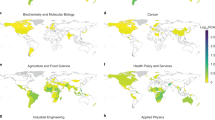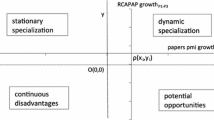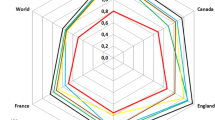Abstract
In order to be able to develop indicators that can measure the scientific and technological productivity of a nation, it is helpful to have at one's command a prior purely descriptive global overview of how various nations stand with respect to each other with regard to world science, i.e., to dispose of a framework for the elaboration of future quantitative studies.
ISI has recently made available a highly comprehensive multidisciplinary database (over 6 million bibliometric entries from 1981 to 1992) that is founded on top-echelon journals and that can form the basis of such a framework. We have in the present study defined a publication pattern per nation that reflects its interest and potential in 18 disciplines and compared the publication patterns of 48 nations by descriptive multivariate analysis, i.e., by measuring the distance between nations in the n-dimensional system. Proximity is a sign of similarity, distance of diversity. Three multivariate methods of distance measurement were used: a hierarchical classification, the distance of each nation from the centre of gravity of the system calculated by χ2-metrics (typicality of behaviour), a bi-plot of the χ2-distances of 46 countries with respect to two reference countries that highlights clusters of nations with similar behaviour.
The resultant plots are open to interpretation by experts. We conclude that three factors, geographical proximity, culture, and economic development are the principal determinants of the publication patterns of nations.
Similar content being viewed by others
References
E. C. Engelsman, A. F. J. van Raan, A patent-based cartography of technology,Research Policy, 23 (1994) 1–26.
J. F. Miquel, J. C. Doré, L'industrie pharmaceutique et la recherche de nouveaux médicaments,Revue d'Economie Industrielle, 18 (1981) 237–255.
F. Narin, E. Noma, R. Perry, Patents as indicators of corporate technological strength,Research Policy, 22 (1993) 108–110.
H. F. Moed, W. J. M. Burger, J. G. Frankfort, A. F. van Raan,On the Measurement of Research Performance: The Use of Bibliometric Indicators, Center for Science and Technology Studies, University of Leiden, Leiden, 1983.
A. Schubert, W. Glänzel, T. Braun, Scientometric datafiles. A comprehensive set of indicators on 2649 journals and 96 countries in all major science fields and subfields, 1981–1985,Scientometrics, 16 (1989) 3–478.
E. Garfield, Citation indexing for studying science,Nature, 227 (1970) 669–671.
E. Garfield,Citation Indexing-Its Theory and Application in Science, Technology and Humanities, John Wiley & Sons, New York, 1972.
D. Chubin, Knowledge and structures of scientific growth: measurement of a cancer problem domain,Scientometrics, 1 (1979) 171–193.
J. C. Doré, M. Boilod-Bouquet, G. Gordon, J. F. Miquel, L'Analyse des aspects essentiels de 35 années d'innovation pharmaceutique,CPA Management, 3 (1983) 37–44.
T. Braun, I. Gomez, A. Mendez, A. Schubert, International co-authorship patterns in physics and its subfields 1981–1985,Scientometrics, 24 (1992) 181–200.
B. R. Martin, J. Irvine, Assessing basic research: Some partial indicators of scientific progress in radio astronomy,Research Policy, 12 (1983) 61–90.
H. P. F. Peters, A. F. J. van Raan, On determinants of citation scores: A case study in chemical engineering,Journal of the American Society for Information Science, 45 (1994) 39–49.
H. Small, Co-citation in the scientific literature. A new measure of the relationship between publications,Journal of the American Society for Information Science, 24 (1973) 265–269.
H. Small, E. Sweeney, Clustering the science citation index using cocitations: A comparison of methods,Scientometrics, 7 (1985) 393–404.
M. Callon, J. P. Courtial, W. A. Turner, S. Bouin, From translation to problematic networks: An introduction to co-word analysis,Social Science Information, 22 (1983) 191–235.
M. Callon, J. Law, A. Rip (Eds),Mapping the Dynamics of Science and Technology, Macmillan Press, London, 1986.
J. F. Miquel, Y. Okubo, Structure of international collaboration in science: Part II: Comparisons of profiles in countries using a LINK indicator,Scientometrics, 29 (1994) 271–297.
Y. Okubo, J. F. Miquel, L. Frigoletto, J. C. Doré, Structure of international collaboration in science: Typology of countries through multivariate techniques using a LINK indicator,Scientometrics, 25 (1992) 321–351.
National Science Board,Science and Engineering Indicators, Washington D. C., 1987.
D. P. Hamilton, Publishing by- and for?-the numbers (News and Comment),Science, 250 (1990) 1331–1332.
D. Pendlebury, Research papers: Who's uncited now?Science, 251 (1991) 25.
J. Cole, N.B. Eales, The history of comparative anatomy—A statistical analysis of the literature,Science Progress, 11 (44) (1917) 578–596.
D. Price, Measuring the size of science,Proceedings of the Israel Academy of Science and Humanities, 4 (1969) 98–111.
P. Hoyningen-Huene,Reconstructing Scientific Revolutions: Thomas S. Kuhn's Philosophy of Science, University of Chicago Press, 1993.
C. Chatfield, A. J. Collins,Introduction to Multivariate Analysis, Chapman and Hall, London, 1989.
M. Jambu,Exploratory and Multivariate Data Analysis, Academic Press, New York, 1991.
G. N. Lance, W. T. Williams, Computer programs for hierarchical polythetic classification (“similarity analyses”),Computer Journal, 9 (1966) 60–64.
L. Lebart, A. Morineau, K. M. Warwick,Multivariate Descriptive Statistical Analysis, Wiley, Chichester UK, 1984.
J. F. Miquel, The changing patterns of international collaboration in universities, In:D. S. Zinberg (Ed.),The Changing University, Kluwer Academic Publishers, Netherlands, 1991, pp. 141–151.
T. Ojasoo, J. C. Doré, J. P. Mornon, J. P. Raynaud, Two approaches to structure-activity relationships in the field of sex-steroids and their analogs, In:M. Bohl, W. L. Duax (Eds),Molecular Structure and Biological Activity of Steroids, CRC Press, Boca Raton, 1992, pp. 157–207.
J. Anderson, P. M. D. Collins, J. Irvine, P. A. Isard, B. R. Martin, F. Narin, K. Stevens, On-line approaches to measuring national scientific output: A cautionary tale,Science and Public Policy, 15 (1989) 153–161.
D. Chubin, Noneconomic Quantitative Measures: The “Output” of Science, In:Research Funding as an Investment: Can we Measure the Returns? Office of Technology Assessment, Washington D.C., 1986, pp. 29–44.
L. Leydesdorff, Problems with the ‘measurement’ of national scientific performance,Science and Public Policy, 15 (1988) 149–152.
J. David, Le français et l'anglais: Réalités sociologiques et impératifs politiques,La Recherche, 8 (1977) 192.
M. Leclerc, Y. Okubo, L. Frigoletto, J. F. Miquel, The scientific co-operation between Canada and the European Community,Science and Public Policy, 19 (1992) 15–24.
S. Ueda, Y. Dewa, K. Kurata, The Japanese scientific and technical journal coverage of 9 databases. A survey,Journal of the Japanese Documentation Society, 33 (1983) 421–430.
E. Ernst, T. Kiefenbacher, Chauvinism,Nature, 352 (1991) 560.
M. Carpenter, F. Narin, The adequacy of the Science Citation Index (SCI) as an indicator of international scientific activity.Journal of the American Society for Information Science, 32 (1981) 430–439.
E. Garfield, How do we select journals for Current Contents?Current Contents, Nov. 5 (1979).
B. R. Martin, The bibliometric assessment of UK scientific performance. A reply to Braun, Glänzel and Schubert,Scientometrics, 20 (1991) 333–357.
T. Ojasoo, J. C. Doré, J. F. Miquel, Regional cinderellas,Nature, 370 (1994) 172.
Author information
Authors and Affiliations
Rights and permissions
About this article
Cite this article
Miquel, J.F., Ojasoo, T., Okubo, Y. et al. World science in 18 disciplinary areas: Comparative evaluation of the publication patterns of 48 countries over the period 1981–1992. Scientometrics 33, 149–167 (1995). https://doi.org/10.1007/BF02020566
Received:
Issue Date:
DOI: https://doi.org/10.1007/BF02020566




